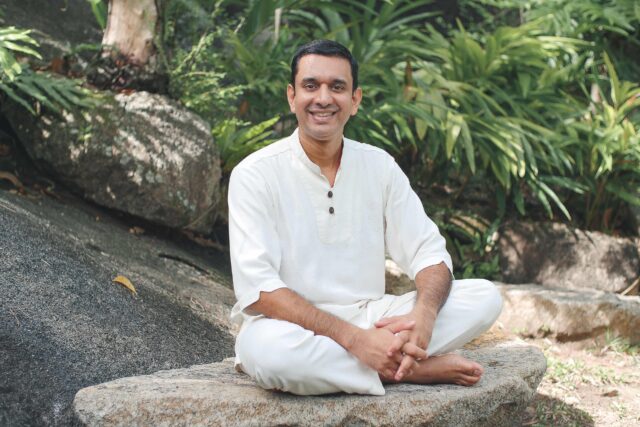It was a video born out of her own frustration and confusion.
The Emirati parkour coach, Amal Murad, speaking in the first of a series of Instagram TV stories, was struggling with how to adapt her normally strenuous fitness regime to all the changes happening to her body when she became pregnant.
Although she had grand intentions of using her workouts to strengthen her body and prepare her for delivery, during the first three months she was so exhausted she didn’t want to move at all.
“It’s so important to talk about this because I personally have felt that I was very lost at the beginning of my pregnancy, when it came to what I can and can’t do,” she told her followers.
She went on to explain that social media offers women mixed messages on the subject: there are fashionistas doing yoga, trainers focused on weight loss and others offering a one-size-fits-all brand of prenatal workout. Instead Murad, who has become a pregnancy and postnatal fitness coach, found pregnancy is a time when women most need to take a “listen to your body” approach.
“Every person is different, every person’s symptoms are going to be different, their changes are going to be different,” said Murad. “Our bodies are going to change, they are going to get bigger in our bust, our rib cage is going to widen…If you don’t know what this does to your body during training, that’s a problem if your trainer isn’t explaining these things to you.”

Tina Bock is a popular and long-time Ashtanga yoga teacher in Abu Dhabi from the US. Now in her third trimester, the 30-year-old says she struggled with how pregnancy impacted her agile body and her six-days-a-week practice.
When morning sickness kept her down during the first trimester, she shifted to shorter practices, walks and swims. Things were fine during the second trimester but by the third she was feeling back pain, getting hormonally emotional and “bigger in general.”
“It’s been frustrating at times to just let my body grow and do what it naturally needs to do, but it’s also been a real lesson in how to practice yoga without needing to do crazy postures, get super sweaty, and feel like I’m ‘working out’ every day,” she says.

Laura Menard-Lee, a 31-year-old teacher from Canada, plans to do the CrossFit she started three years ago through her entire pregnancy, if possible. But she has made some big adjustments to her previous regimen, which involved working out two hours a day, six days a week.
In the first trimester she cut out the second hour and reduced abdominal movements, to avoid diastasis recti, or abdominal separation – one of her biggest fears. She accepted that she would no longer be pushing herself to “her absolute limit” and credits her coach Rob Anthony for helping her make the transition.
“Overall, I feel like having a coach like coach Rob, who is knowledgeable enough to guide me through the process, has helped tremendously, and has made me confident that I and the baby will be safe and healthy continuing CrossFit throughout my pregnancy,” she said.
Experts in this field say it’s entirely possible to keep up a vigorous workout schedule during pregnancy, while following some important guidelines and scaling down where necessary. Women like Menard-Lee are on the right track when it comes to avoiding abdominal work to avoid permanently damaging those muscles, says Dr Rosalie Sant, obstetrician and gynecologist at Primavera Medical Center in Dubai.
“The other area that comes under a lot of pressure is the pelvic floor,” she says. “Unless it is properly engaged, especially when the intra-abdominal pressure is raised during exercise or if the exercise involves a bounce, these will stretch and damage even before delivery.”
Delivery puts the pelvic floor under further pressure, which is why women need to make sure they are engaging properly during pregnancy workouts. Higher levels of progesterone loosen the ligaments, so joints are more susceptible to injury – meaning it’s more important than ever to do each exercise properly.
Women also need to hold back on the intensity of their workouts, says Dr Sant.
“If they push themselves very hard, the circulation will be diverted to their muscles and not enough blood will go centrally to the internal organs,” she says. “The kidneys can survive very well with slightly less oxygen, for a while, but the embryo cannot.”
Dr Sant tells many of her newly pregnant patients to visit a physiotherapist who specializes in women’s health for specific instruction on how to carry on their exercise regimes safely. (She also advises: “If in doubt, go for a swim. Best exercise ever for a pregnant woman.”)
Amy Gilbert, owner of Perfect Balance Rehabilitation Centre and a member of the livehealthy.ae expert panel, is such a specialist. The most important thing to do first is establish each woman’s pre-pregnancy activity level, she says.
“If the body is accustomed to a particular type of exercise, for example, weight lifting or marathon running, then it is a matter of listening to your body,” she says.
One client Gilbert worked with, a high-level CrossFit, running and weightlifting enthusiast, was able to go to the gym up until the last week of her pregnancy. Her monthly checkups monitored her abdominals and pelvic floor function. Her first trimester energy levels didn’t drop too much, although she needed to exercise after eating, not before. During the second trimester, they scaled back overhead movements to avoid abdominal strain, walking took the place of running and medicine balls and body weight replaced heavy weights.
“She remained injury free and made a great recovery back to her normal activity with guidance,” says Gilbert.
Contact sports, extreme heat and twists are all to be avoided, and generally high-impact activities that put pressure on the pelvic floor should be scaled down in latter stages of pregnancy, says Sue Bryant, a midwife trained in the UK and a pre-natal yoga and yoga instructor at YogaOne in Abu Dhabi.
However, she adds a gentle reminder that women have been “pregnant forever,” regularly picking up heavy older toddlers without incident.
“I would encourage a woman to continue to exercise within her own capabilities as long as she is comfortable and has no risks to her unborn baby,” she says. “I would also suggest that she may well feel very differently when pregnant and to be guided by how she feels. At the end of the day, pregnancy is not an illness, and if low-risk, should be considered a normal part of life and not a medical problem.”
Kayleigh Dawson, a fitness coach in Dubai, says working out during pregnancy can help ease stress and anxiety, promote better sleep and help ward off excessive weight gain. She makes sure her clients consult a doctor, that they consider their previous level of activity, monitor how they feel during each workout to make sure they are comfortable, and stay hydrated and fueled. And she always reminds them when they get tired and frustrated of the big job their bodies are already doing.
“When I deal with pregnant ladies and they speak to me about their bodies,” says Dawson, “I always get them to understand the fact that they are growing a person inside them.”
Featured image: Shutterstock






